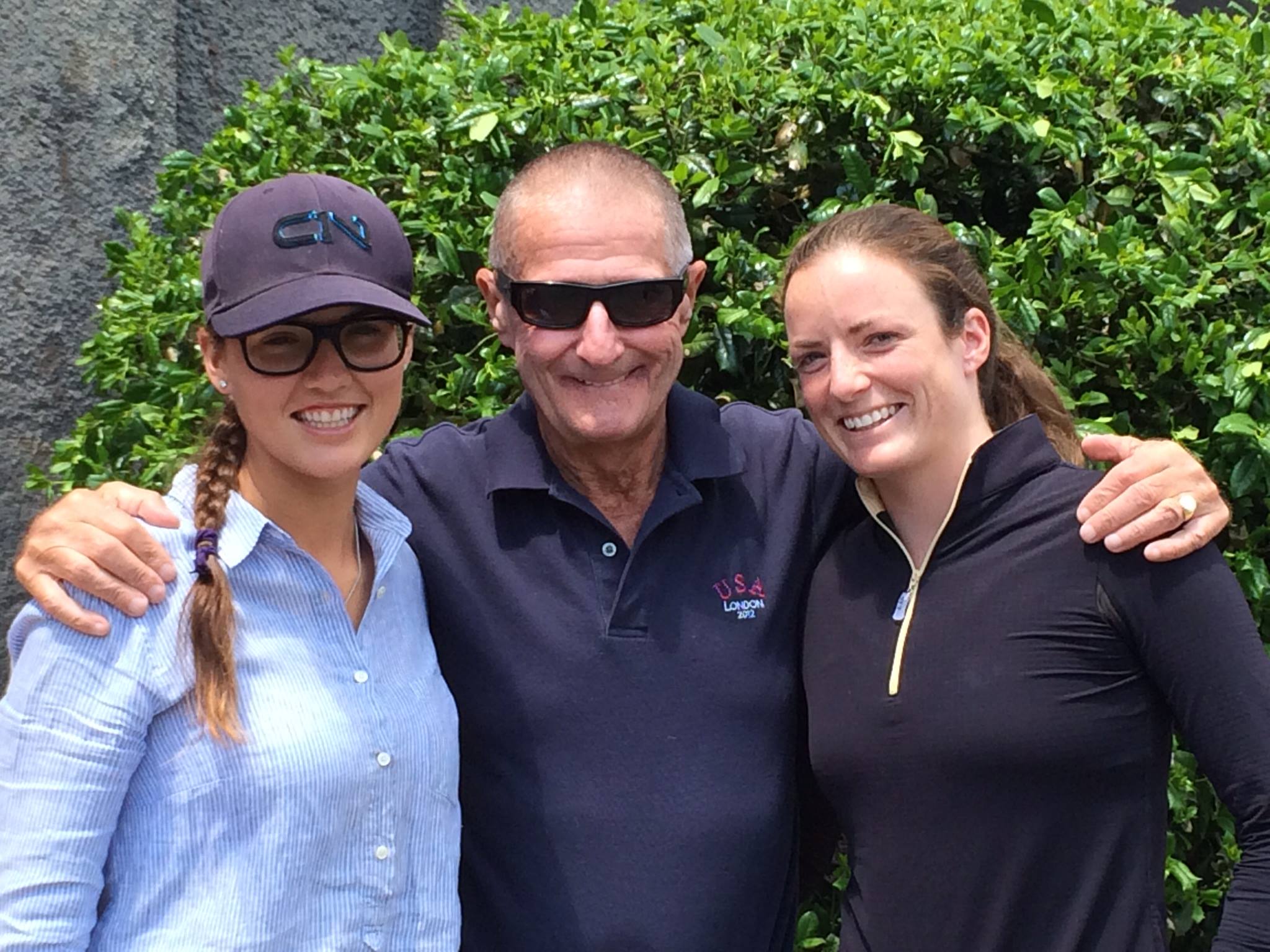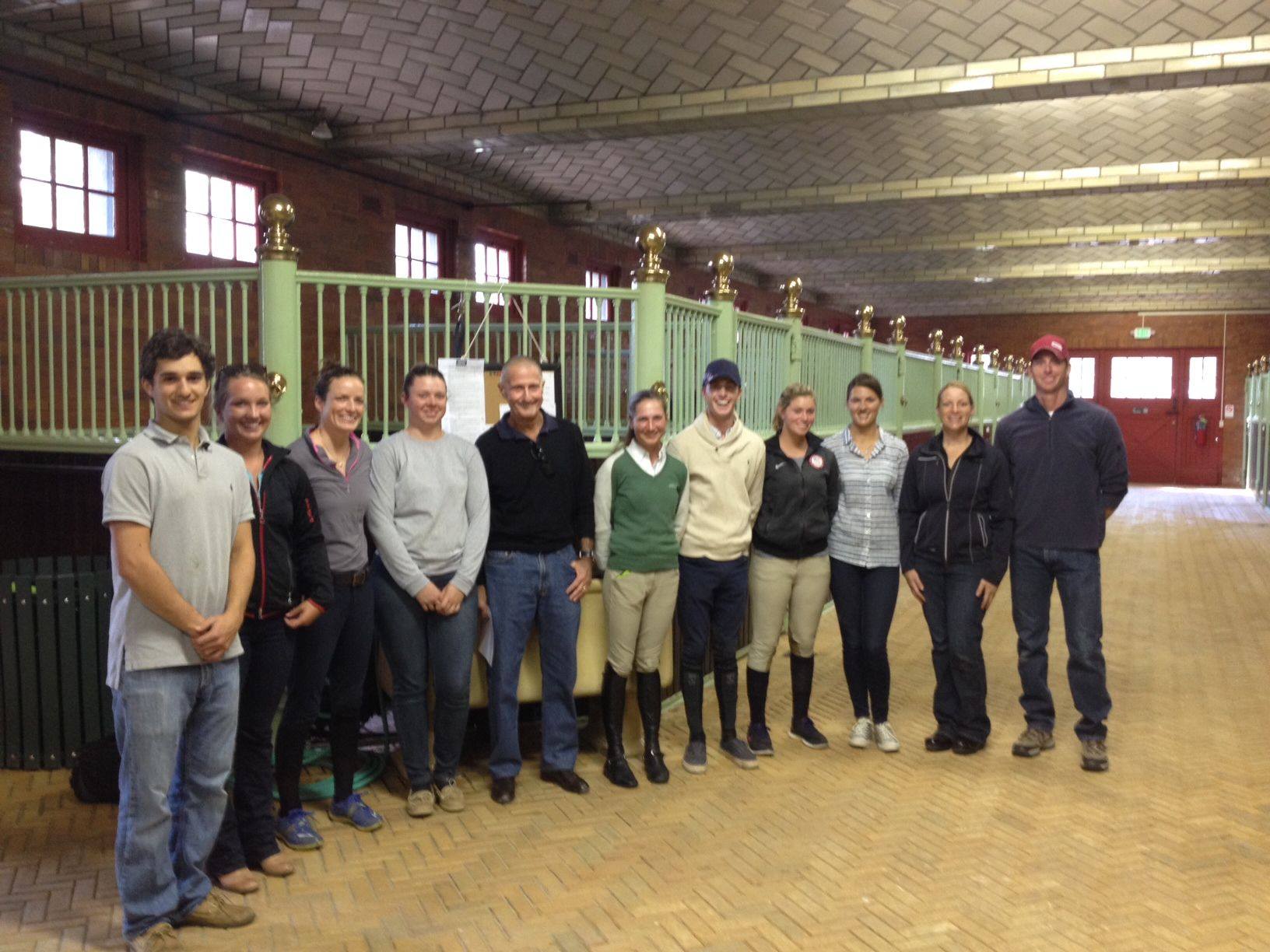Gymnastics and Forward Foundations for Day Two of George H. Morris Gladstone Program
Gladstone, NJ – May 21, 2014 – Day two of the 2014 George H. Morris Gladstone Program got underway at the USET Foundation’s Headquarters at Hamilton Farms early Wednesday morning. Riders were expected to put their newly learned knowledge to the test, continuing their work on the flat in order to better prepare their mounts for the gymnastics session in the afternoon where they would face cavaletti, gymnastic work, and a liverpool.
Legendary horseman George Morris instructed Brittni Raflowtiz, Maggie McAlary, Sloane Coles and Scott Lico to work their horses around half the ring, using self-activity and putting yesterday’s knowledge into practice. Jacob Pope watched Morris from the side as he worked with his mount to round the poll and straighten, working with the horse’s mouth to sensitize and utilize leg aids.
“The French call it ‘petite attaque’ meaning small attack,” Morris stated as he put the horse to the bit. “The trick is to push not pull, give a little and then take a little. You want the horse to fall into rhythm, and have contact with the bit. Once they are going with the impulsion, they have no choice; the horse will stretch into the bit. You must know the difference between stretching and leaning.”
Dr. Gerd Heuschmann welcomed Alec Bozorgi, Karina Busch, Katie Cox, Christi Israel and Savannah Talcott to the second mounted session of the morning. Dr. Heuschmann mounted Karina Busch’s horse, and from the moment he positioned himself the familiarities in his and Morris’ riding styles were uncanny. He reinforced his hand position by keeping his hands symmetrical with the horse’s mouth.
The gymnastics mounted session saw the 10 riders in the two groups, using a condensed work model on the flat to loosen the horses and work on suppleness. Utilizing the Heuschmann’s principles discussed over the two days, the riders continued to work on classical riding techniques, focusing on a light seat and keeping the horse balanced with their legs and hands. Morris then instructed the riders to move through the cavalettis, maintaining rhythm and allowing their horse to get there without hesitation. Even through the cavalettis the riders focused on keeping a forward seat, similar to that of the obstacles they would soon progress on to.
Morris had them complete several figure eights over the cavalettis, interpreted as “little obstacle,” and then focus on a series of four small verticals set on a circle. “You always want to be progressive when training a horse. We start with two fences, then progress to three, and then four,” Morris described.
“You may not get it right the first time, or even the second time,” Morris explained. “It takes years of practice to get to the level of Beezie [Madden], McLain [Ward] or Laura [Kraut], but we are working to build you and the horse to get there.”
The riders focused on holding their position throughout the exercise, keeping contact with a half halt after each fence, by raising their hands slightly. Each rider kept the inside rein open, using the outside leg to guide and allow the horse to bend around the inside leg. When Morris was satisfied with each of the riders, he moved on to a single triple bar.
Morris always focuses on the forward seat as part of his clinics, working to get the horses to go with the riders versus bracing and resisting with too deep of a seat. The riders were asked to approach the triple bar at a forward pace in a two-point position, moving into a light three-point position about eight strides away from the obstacle.
As soon as each rider completed the triple bar, Morris added a vertical-vertical one-stride combination set next to the water. He focused on having the riders look for a deep approach to the fences so that the horses sit back on their hocks, using impulsion to move them through the combinations. After taking six strides to an oxer set on the left from the combination, the riders moved on to the liverpool, an obstacle that proved spooky for several.
“This is where you have to ask what impulsion your horse needs,” Morris asked of his students. “Does your horse need a cluck? A little spur? A stick? You need to think quickly and understand how to keep your horse thinking forward. You must anticipate and predict.”
“I didn’t exactly know what to expect when going into the gymnastics session today,” Raflowitz said. “I have only had my mare for a month, but I was prepared to expect the unexpected. She was super, and I couldn’t have asked her to be any better than she was. Everything George has to say is quite interesting since he has a very different teaching style than anyone I have worked with. I need to work on being softer in the seat, not riding so rigid and so deep in my seat.”
Raflowitz continued, “This clinic is so unique, it combines lectures with professionals in the industry, and an unfathomable amount of knowledge can be gained. Today we met with Yvonne Ocrant, a lawyer, and it was extremely interesting. She kept us engaged, and I came away with a better understanding for a business on both a day-to-day and law-based way. She really explained how to turn what we love to do into a successful business, but we also learned the importance of protecting our business.”
The instructions through the gymnastics provided educational tools for horse and rider, actively fulfilling the purpose of the 2014 George H. Morris Gladstone Program. The Gladstone Program incorporates a unique design, utilizing professionals and experts across the equestrian industry to build knowledge for the riders in an effort to pursue a path that will prepare them to be a “team” rider and represent the United States in international competition.
The United States Equestrian Team Foundation (www.uset.org) is the non-profit organization that supports the competition, training, coaching, travel and educational needs of America’s elite and developing international, high-performance horses and athletes in partnership with the United States Equestrian Federation.

